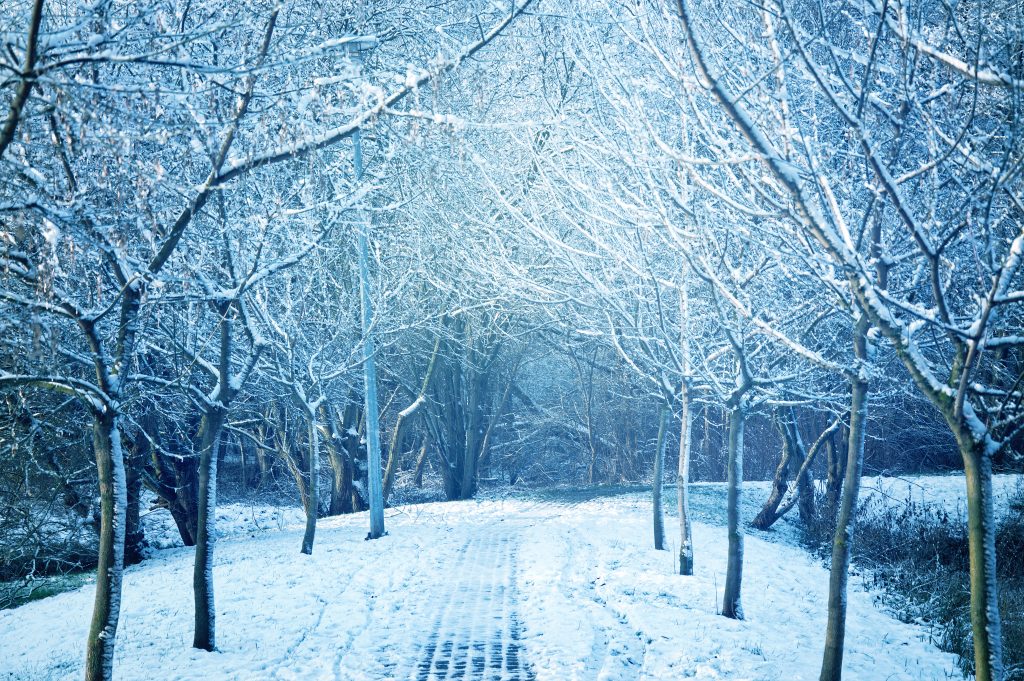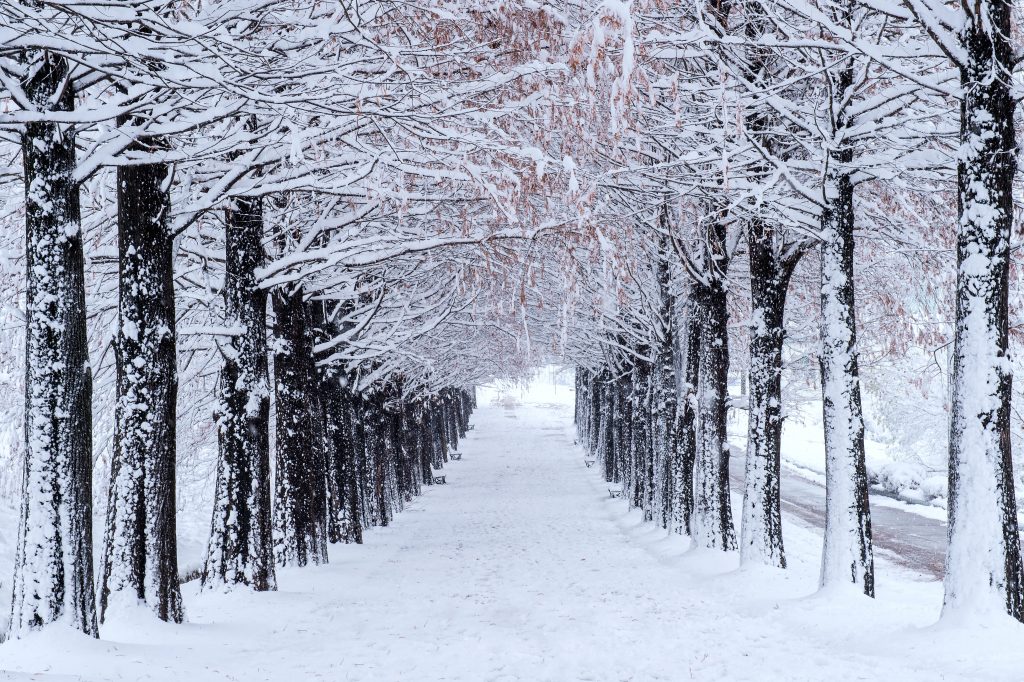Winter care for trees is essential to ensure their health, resilience, and longevity during the harsh conditions of the cold months. Trees are living organisms, and just like any other living thing, they require special attention and care to thrive even when faced with adverse weather. The importance of winter tree care can be understood through several key points:

1. Moisture Retention: Winter conditions, including cold winds and low temperatures, can lead to the loss of moisture from tree tissues. Proper winter care practices like mulching and adequate watering before the ground freezes help trees retain the moisture they need to stay healthy.
2. Root Health: Trees depend on healthy root systems to absorb water and nutrients. Cold temperatures can lead to frozen soil, making it difficult for roots to access water. Ensuring proper hydration and insulation through mulching contributes to maintaining robust root health.
3. Preventing Desiccation: Evergreen trees and shrubs continue to lose water through their leaves during winter, a phenomenon known as desiccation. Applying anti-desiccant sprays and wrapping sensitive trees can protect them from excessive moisture loss.
4. Minimizing Sunscald: Sunscald occurs when the bark heats up on sunny winter days and then rapidly cools at night, causing cracks and damage. Proper winter care practices like wrapping tree trunks and positioning trees to minimize exposure to direct sunlight can prevent sunscald.
5. Reducing Winter Stress: Trees naturally go through a period of dormancy during winter, but they can still experience stress due to extreme cold, freezing and thawing cycles, and harsh winds. Winter care measures such as pruning weak branches and applying winter mulch can reduce this stress.
6. Pest and Disease Management: Some pests and diseases are more active during winter, taking advantage of weakened trees. By practicing winter care routines like monitoring for pests, applying dormant oil sprays, and addressing potential issues early, you can prevent infestations and diseases.
7. Snow and Ice Load: Accumulation of heavy snow and ice on branches can cause them to bend, break, or even uproot entire trees. Proper snow removal techniques and assessing trees for hazards during and after winter storms can help prevent such damage.
8. Long-Term Tree Health: The effects of winter stress and damage can carry over to the following growing season, affecting tree growth, leaf production, and overall health. Proper winter care sets the foundation for a healthy and vibrant growing season.
9. Economic and Aesthetic Value: Trees contribute to property value, aesthetics, and overall landscape appeal. Well-maintained trees are more likely to thrive and continue enhancing your property’s beauty and value.
10. Environmental Impact: Healthy trees play a crucial role in the environment by absorbing carbon dioxide, releasing oxygen, providing wildlife habitats, and reducing erosion. By ensuring their health during winter, you contribute to the overall well-being of the ecosystem.
Winter care for trees is a vital investment in their well-being. By implementing proper care practices, you provide trees with the best chance to withstand winter challenges, recover quickly in spring, and continue to offer their numerous benefits for years to come.
Harsh weather conditions can have significant impacts on trees, affecting their health, structural integrity, and overall well-being. Trees are susceptible to a range of adverse weather conditions, each of which presents unique challenges. Here’s an overview of the impacts of harsh weather conditions on trees:

• Dehydration: Cold temperatures can cause trees to lose moisture through their leaves and stems. This dehydration can stress trees and compromise their health.
• Freezing and Thawing: Fluctuations between freezing and thawing can lead to soil heaving, damaging roots and causing instability.
• Root Stress: Frozen soil can limit water uptake by roots, potentially leading to root stress and decreased nutrient absorption.
• Desiccation: Cold winds can accelerate water loss through tree leaves, causing desiccation and weakening the tree.
• Branch Breakage: Strong winds can lead to branch breakage, especially if the tree’s structure is compromised or weak.
• Branch Breakage: Heavy snow and ice accumulation on branches can cause them to bend, break, or split under the weight.
• Uprooting: Snow and ice loading can destabilize a tree’s root system, leading to uprooting in extreme cases.
• Sunscald: Sunlight reflecting off snow can cause temperature fluctuations on tree bark, leading to sunscald and bark damage.
• Water Stress: Lack of adequate moisture during drought conditions can stress trees and weaken their ability to resist pests and diseases.
• Premature Leaf Drop: Trees may shed leaves prematurely as a survival mechanism to conserve water during drought.
• Wilting: Excessive heat can cause water loss through transpiration faster than roots can absorb it, leading to wilting and stress.
• Scorching: Intense heat and direct sunlight can scorch leaves, causing them to turn brown or yellow.
• Branch Breakage and Uprooting: Strong winds during storms can snap branches or uproot entire trees.
• Structural Damage: Trees with weak or compromised structures are particularly vulnerable to wind damage.
• Leaf and Stem Damage: Hailstones can cause physical damage to leaves, stems, and branches, reducing the tree’s ability to photosynthesize and grow.
• Root Suffocation: Prolonged flooding can lead to waterlogged soil, suffocating roots and causing stress or death.
• Soil Erosion: Floodwaters can erode soil around tree roots, destabilizing their anchorage.
• Soil Compaction: Roadside trees exposed to salt and deicing chemicals can suffer from compacted soil, hindering root growth and water absorption.
• Foliage Damage: Salt spray can damage leaves, leading to browning and reduced photosynthesis.
• Combined Stress: Trees facing multiple harsh weather conditions simultaneously can experience compounded stress, weakening their overall health and resilience.
The impacts of harsh weather conditions on trees highlight the importance of proactive tree care, especially during vulnerable periods. Proper maintenance, timely assessments, and preventive measures can help mitigate the negative effects of adverse weather, ensuring trees remain healthy and able to withstand the challenges they face.
Preparing trees for winter is a crucial aspect of tree care to ensure their health and survival during the harsh conditions of the cold months. Proper preparation can help trees withstand freezing temperatures, strong winds, and potential stressors.
Here’s a step-by-step guide on how to prepare trees for winter:
• Before winter arrives, conduct a thorough inspection of your trees.
• Look for weak or overhanging branches, signs of disease, pest infestations, and structural issues.
• Identify any areas of concern that might become more vulnerable during winter weather.
• Give trees a deep watering before the ground freezes.
• Moist soil helps trees enter dormancy in a hydrated state, improving their ability to withstand winter conditions.
• Apply a layer of mulch around the base of trees, extending to the drip line but avoiding contact with the trunk.
• Mulch insulates the soil, regulates temperature fluctuations, and retains moisture.
• Prune away dead, weak, or diseased branches. This reduces the risk of breakage under heavy snow or ice.
• Proper pruning improves overall tree structure and reduces the potential for winter damage.
• Wrap the trunks of young or sensitive trees with burlap or tree wraps to protect against frost cracks and sunscald.
• Wrapping also helps prevent rodent damage to the bark during winter.
• Apply anti-desiccant sprays to the foliage of broadleaf evergreens to prevent moisture loss through leaves.
• These sprays create a protective layer that reduces water loss due to harsh winter winds.
• Install temporary windbreaks made of burlap or fabric on the windward side of vulnerable trees.
• Windbreaks shield trees from harsh winter winds, reducing moisture loss and physical damage.
• Wrap tree trunks with hardware cloth or fencing to prevent rodents and other animals from gnawing on the bark or causing damage.
• Clear debris and fallen fruit from around trees to discourage wildlife from congregating near them.
• Apply dormant oil sprays to tree branches and trunks to control overwintering pests and their eggs.
• Dormant oil suffocates pests while causing minimal harm to beneficial insects.
• If there are dry spells during winter, water young or newly planted trees to prevent dehydration.
• Use a soaker hose to provide slow, deep watering directly to the root zone.
• Keep an eye on your trees during winter, especially after severe weather events.
• Check for signs of stress, damage, or pests that might have emerged during the dormant season.
• Gradually transition trees into spring care routines as temperatures rise and the ground thaws.
• Resume regular watering and prepare for the growing season ahead.
By following these steps, you can help your trees enter winter in the best possible condition, minimizing the impact of harsh weather and setting the stage for their successful emergence in the spring.
[geocentric_weather id=”45ff4ccd-3d3f-498e-b0b9-91aaaf766bc4″]
[geocentric_about id=”45ff4ccd-3d3f-498e-b0b9-91aaaf766bc4″]
[geocentric_neighborhoods id=”45ff4ccd-3d3f-498e-b0b9-91aaaf766bc4″]
[geocentric_thingstodo id=”45ff4ccd-3d3f-498e-b0b9-91aaaf766bc4″]
[geocentric_busstops id=”45ff4ccd-3d3f-498e-b0b9-91aaaf766bc4″]
[geocentric_mapembed id=”45ff4ccd-3d3f-498e-b0b9-91aaaf766bc4″]
[geocentric_drivingdirections id=”45ff4ccd-3d3f-498e-b0b9-91aaaf766bc4″]
[geocentric_reviews id=”45ff4ccd-3d3f-498e-b0b9-91aaaf766bc4″]